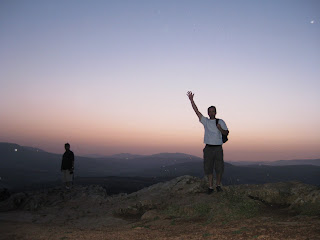Friday 24 April
Drive to Jerusalem and then Tel Aviv.
The two cars took different routes to Tel-Aviv. One left early to travel along the Jordan Valley, the other left later and went via mount Carmel and Hiafa. The Jordan Plain is very fertile, and both the Jordanians, and the Israelis are taking advantage of this productive land. Looking up onto the hills of Samaria or the West Bank from the Jordan plain it is just desolate, and forboding. We saw the valley where the Jabbock stream flows into the Jordan.
View across the Jordan Valley to the hills of Modern Jordan (Ancient Amman) in the distance. Extensive agriculture happenning along its entire length.
We also saw the border fence that the Israelis maintain between the West bank and the section that the Jews have settled along the Jordan Valley. We also passed the town of Adam, where the river Jordan flowed back to when the Israelites crossed it in the beginning. We also passed Gilgal! So many places that you read about in the Bible, it is such an exciting experience.

Israeli border patrol. They drive up and down this road along the Jordan each day dragging a mesh grate that leaves a trail of fine dust that will reveal any trace of footprints of those who attempt to approach near to the Electric fence to cross (the fence is behind the patrol).
We arrive at Jerusalem. Some went in for the Ha-Kotel (Western Wall) Tunnel, Ruth and myself went into the Archeological gardens around the Temple mount. Interesting to see the actual pavement that Christ walked on, and see the huge stones that the Roman cast down from the top of the Temple Mount. Just as Jesus had prophesied, “not one stone would remain upon another”.

One of the huge stones that was 'cast down' from the top of the wall in the background
We drove on to Tel-Aviv to return the cars and check in for our return flights. A time of mixed feelings after a tremendous time together in the Promised land.
An intersting World Peace Memorial in Jerusalem - It reminded me of the 'Gordian Knot'. I thought this very nicely sums up the world's hope of solving the predicament of war and conflict on its own. It needs a deliverer to come along with a radical solution just like Alexander the Great did with the Gordian knot.

Steve (always willing to help) putting his shoulder to the wheel. An ancient Mill Stone in Jerusalem.
 As Darren described the computer stalls in Bangkok they are like Harvey Norman (A computer chain store in Australia) on steroids. The photo only captures about 1/6 of the store
As Darren described the computer stalls in Bangkok they are like Harvey Norman (A computer chain store in Australia) on steroids. The photo only captures about 1/6 of the store The weary crew (minus the Ginns who have stayed another two days in Bangkok) back home at Sydney Airport.
The weary crew (minus the Ginns who have stayed another two days in Bangkok) back home at Sydney Airport.




















































